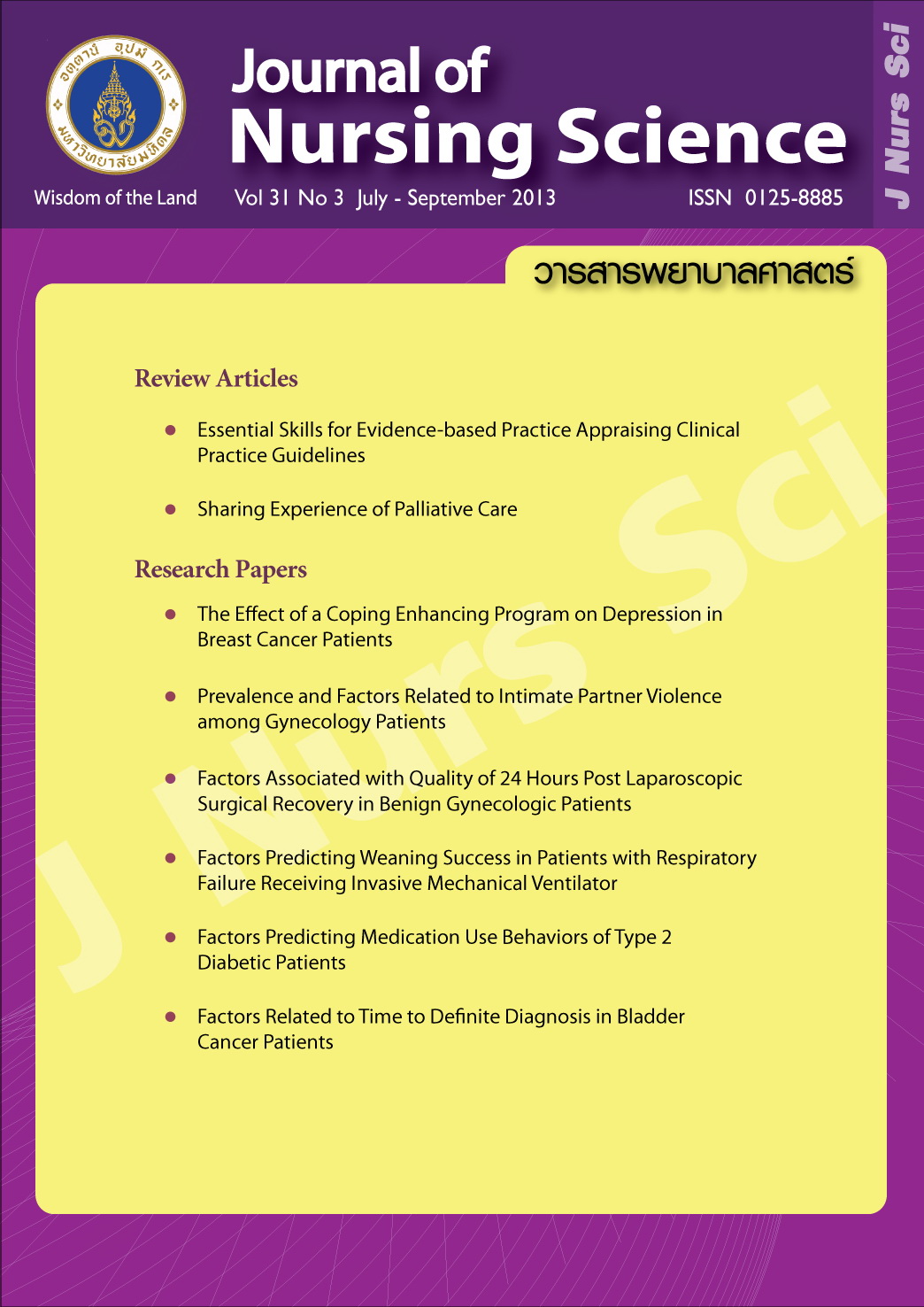Factors Predicting Weaning Success in Patients with Respiratory Failure Receiving Invasive Mechanical Ventilator
Main Article Content
Abstract
Purpose: This secondary analysis aimed to study predictive power of age, gender, perceived selfefficacy for weaning, perceived severity of illness, and anxiety on weaning success in patients with respiratory failure receiving invasive mechanical ventilator. Spontaneous breathing trial at first 120 minutes was used as the method of weaning in this study.
Design: Correlational predictive design.
Methods: From the primary study, the data were collected at two tertiary hospitals. In this study, the data from 147 participants in both groups of weaning success and failure were used for analysis using descriptive statistics and logistic regression.
Main findings: About half (53.1%) of the participants were male, and average age were 66.3 years. Only 2 factors could significantly predict weaning success at p < .05. That is, perceived self-efficacy for weaning increased chance in succeed weaning (odds ratio = 1.08, 95% CI 1.05 - 1.12); and anxiety decreased chance in succeed weaning (odds ratio = 0.98, 95% CI 0.96 - 0.99). All study factors could explain 66% of the variance in weaning success.
Conclusion and recommendations: Nursing interventions should be developed to promote perceived self efficacy for weaning and reduce anxiety before performing spontaneous breathing trial in each patient.
ปัจจัยทำนายความสำเร็จในการหย่าเครื่องช่วยหายใจของผู้ป่วยที่มีภาวะหายใจล้มเหลวที่ใส่ท่อและเครื่องช่วยหายใจ
ดวงรัตน์ วัฒนกิจไกรเลิศ, ฐิติพร ปฐมจารุวัฒน์, เดช เกตุฉ่ำ
บทคัดย่อ
วัตถุประสงค์: การวิจัยครั้งนี้เป็นการวิเคราะห์ทุติยภูมิเพื่อศึกษาความสามารถในการทำนายของปัจจัยด้านเพศ อายุ การรับรู้สมรรถนะตนเองในการหย่าเครื่องช่วยหายใจ การรับรู้ความรุนแรงของการเจ็บป่วย และความวิตกกังวลก่อนที่จะหย่าเครื่องช่วยหายใจต่อความสำเร็จในการหย่าเครื่องช่วยหายใจโดยการหายใจเองใน 120 นาทีแรก ของผู้ป่วยที่มีภาวะหายใจล้มเหลวที่ใส่ท่อและเครื่องช่วยหายใจ
รูปแบบการวิจัย: ศึกษาความสัมพันธ์เชิงทำนาย
วิธีดำเนินการวิจัย: ข้อมูลจากงานวิจัยปฐมภูมิเก็บที่โรงพยาบาลตติยภูมิ 2 แห่ง ในการวิจัยครั้งนี้ผู้วิจัยใช้ข้อมูลกลุ่มตัวอย่างทั้งหมดรวม 147 คน แบ่งเป็นกลุ่มที่หย่าเครื่องช่วยหายใจสำเร็จและกลุ่มที่หย่าเครื่องช่วยหายใจไม่สำเร็จ วิเคราะห์ข้อมูลด้วยสถิติเชิงพรรณา และการวิเคราะห์การถดถอยโลจิสติก
ผลการวิจัย: กลุ่มตัวอย่างร้อยละ 53.1 เป็นเพศชาย อายุเฉลี่ย 66.63 ปี ปัจจัยที่สามารถทำนายความสำเร็จในการหย่าเครื่องหายใจโดยการทดสอบการหายใจเอง ใน 120 นาทีแรก อย่างมีนัยสำคัญทางสถิติที่ระดับ p < .05 ได้แก่ การรับรู้สมรรถนะตนเองในการหย่าเครื่องช่วยหายใจโดยจะช่วยเพิ่มโอกาสในการหย่าเครื่องช่วยหายใจสำเร็จคิดเป็น 1.08 เท่า (95% CI 1.05 - 1.12) และความวิตกกังวลจะลดโอกาสในการหย่าเครื่องหายใจได้คิดเป็น 0.98 เท่า (95% CI 0.96 - 0.99) โดยปัจจัยทั้งหมดสามารถทำนายความสำเร็จในการหย่าเครื่องช่วยหายใจได้ร้อยละ 66
สรุปและข้อเสนอแนะ: พยาบาลควรพัฒนารูปแบบและกิจกรรมการพยาบาลเพื่อส่งเสริมให้ผู้ป่วยมีการรับรู้สมรรถนะตนเองในการหย่าเครื่องช่วยหายใจ และลดความวิตกกังวลก่อนทำการทดสอบการหายใจเองในผู้ป่วยทุกราย
คำสำคัญ: ความวิตกกังวล การรับรู้สมรรถนะตนเอง การรับรู้ความรุนแรงของการเจ็บป่วย การหย่าเครื่องช่วยหายใจ
Article Details
Copyright Notice: Nursing Science Journal of Thailand has exclusive rights to publish and distribute the manuscript and all contents therein. Without the journal’s permission, the dissemination of the manuscript in another journal or online, and the reproduction of the manuscript for non-educational purpose are prohibited.

Disclaimer: The opinion expressed and figures provided in this journal, NSJT, are the sole responsibility of the authors. The editorial board bears no responsibility in this regard.


